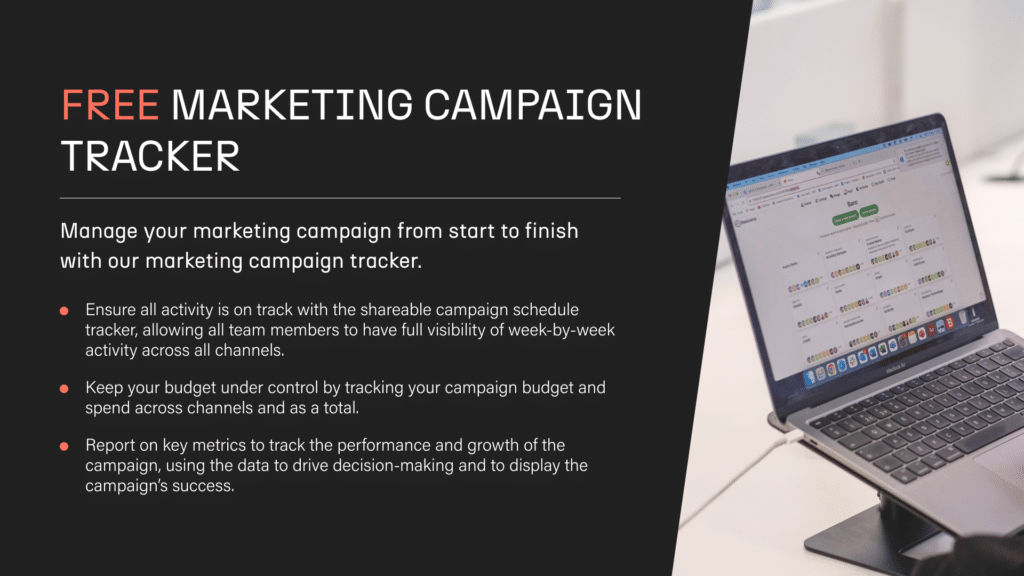How to Manage and Track a Marketing Campaign [with Template]
You’ve pushed your marketing campaign live and you’re ready to see the results come pouring in. To get a proper view of how well things are performing, however, you’ll need to manage and track your campaigns. And to do that, you need the right tools to make sure activity runs smoothly, campaign goals are met and the correct metrics are being tracked.
So how do you measure the success of a marketing campaign? We’ll show you. Over the course of this article, we’ll let you in on how to manage, monitor and gauge the success of your campaign once the dust has settled.
We’ve even created a downloadable Marketing Campaign Tracker for you to fill in with your cross-channel schedules, budgets and performance figures and statistics over the course of your campaigns, so that you and your team can understand how things are progressing.
Quick Navigation
Managing your campaign
Managing multiple teams and members
Everyone should be clear what they need to do over the course of the campaign regarding their own input. Project management software like JIRA, Basecamp and Trello can make task assignment a much clearer process, and let’s everyone know the parts they have to play in a campaign – which is vital in making sure the whole team is accountable.
Using the right organisation tools
At the outset, you should have a bank of software, platforms and tools designed specifically to keep the plates spinning over the course of a campaign. Asana, JIRA, HubSpot and Salesforce are particularly useful we’ve found, providing you with key reports and task automation and they can be scaled as and when you need them to.
Monitoring your campaign
Workflows and timelines
What are the steps you’ll take from the campaign’s start right up to its completion? By making these expectations clear, along with the timeframes need to complete them in, your team’s work will be more efficient and of a higher standard over the course of your campaigns.
Goal check-ins
Keeping track of how things are progressing, whether it’s on a daily, weekly or monthly basis, by holding meetings and sessions lets the team know whether things are working, not working and where improvements might need to be made. Make sure you’re setting time aside for the whole team to inform everyone else of where they are.
Tracking your campaign’s performance
What metrics should you be tracking?
The effectiveness of your campaign will depend largely on the metrics you plan on tracking. While vanity metrics might sound like a good idea, they provide little in the way of actual substance. Instead, try and link the metrics you want to track to your campaign’s original goal. By working backwards this way, you can identify more actionable metrics that provide greater insight into the success of your campaigns.
Using data for decision making
Data is a powerful thing, so it’s important to use it to your advantage. For starters, it’s entirely objective, providing a clear sign that your campaign is or isn’t succeeding. It’ll also clue you into the hard facts surrounding your audience and their behaviours. So it’s a good idea to heed what it’s saying. By diving into your data, you’ll be able to see whether a channel is under-performing or you’re going over budget, for example. From here, you can then start to adjust your strategy to rectify where you’re going wrong.
Measuring the success of your campaign post-launch
Goals and KPIs
If the importance of setting goals and KPIs wasn’t clear already, then the need for both is absolutely crucial if you’re to measure the success of your campaign. Ultimately, did your campaign succeed in meeting the desired action i.e., your SMART goals and the according KPIs that required fulfilling to meet these goals? If so, then pat yourself on the back, the campaign was clearly a success.
Demonstrating the ROI
Likewise, you’ll also want to see whether the cost of the project was worth your effort. In a digital marketing context, demonstrating ROI can be a bit of a challenge, especially since there are several different ways to calculate marketing ROI. With that said, the core formula used to get an idea of your success is as follows:
(Sales Growth – Marketing Cost) / Marketing Costs = Marketing ROI
However, this formula assumes that all sales growth is tied to marketing efforts. Since that’s not necessarily true, it’s important to account for organic sales using this formula:
(Sales Growth – Organic Sales Growth – Marketing Cost) / Marketing Cost = Marketing ROI)
Learnings and future campaigns
Your final campaign report will provide you with a debriefing that sums up your successes, but also lays out what you’ve learned. And it’s these learnings that will inform your future campaigns.
In your report, or a meeting with your team, be sure to ask what you could’ve done differently, where could you have saved money, why things went wrong (if they did, of course), anything you learned about your audience, and whether there is any feedback you could glean from anyone else who worked on the campaign.
By reflecting on things like this, you’ll be able to strengthen your strategy, as well as any campaigns you and your team create in the future.
Your free Marketing Campaign Tracker
Preparation is key. Get your planning off to a stronger start with our free Marketing Campaign Tracker – a place to keep your cross-channel schedules, budgets and performance tracking to hand at all times through your campaign.

Every single marketing campaign starts with knowledge. By getting to know your business, your audience and your goals, we’ll work with you to put a top-notch digital marketing strategy into action. For more info, head to our homepage or give us a call on 0345 459 0558.



